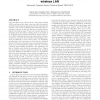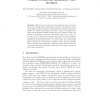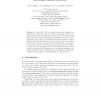157 search results - page 25 / 32 » Anonymous Signatures Revisited |
ACISP
2009
Springer
14 years 2 months ago
2009
Springer
In the setting of identity-based encryption with multiple trusted authorities, TA anonymity formally models the inability of an adversary to distinguish two ciphertexts correspondi...
EUROCRYPT
1998
Springer
13 years 12 months ago
1998
Springer
Abstract. Provable security is a very nice property for cryptographic protocols. Unfortunately, in many cases, this is at the cost of a considerable loss in terms of efficiency. Mo...
INFOCOM
2011
IEEE
12 years 11 months ago
2011
IEEE
User association logs collected from a large-scale wireless LAN record where and when a user has used the network. Such information plays an important role in wireless network res...
PAIRING
2009
Springer
14 years 2 months ago
2009
Springer
Abstract. Efficient non-interactive zero-knowledge proofs are a powerful tool for solving many cryptographic problems. We apply the recent Groth-Sahai (GS) proof system for pairing...
PKC
2005
Springer
14 years 1 months ago
2005
Springer
To sign with RSA, one usually encodes the message m as µ(m) and then raises the result to the private exponent modulo N. In Asiacrypt 2000, Coron et al. showed how to build a secu...



